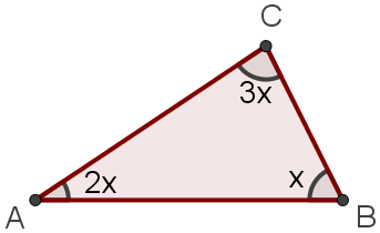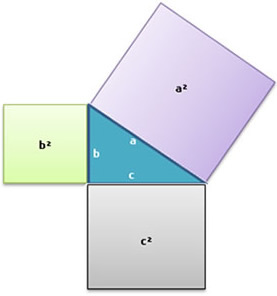Scientific notation is used to reduce writing very large numbers using the power of 10.
Test your knowledge with the following questions and clear your doubts with comments in the resolutions.
question 1
Pass the numbers below for scientific notation.
a) 105,000
Correct answer: 1.05 x 105
1st step: Find the value of N walking with the decimal point from right to left until you reach a number less than 10 and greater than or equal to 1.
1.05 is the value of N.
Step 2: Find the value of no counting by how many decimal places the comma went.
5 is the value of no, because the comma has moved 5 decimal places from right to left.
3rd step: Write the number in scientific notation.
The scientific notation formula being N. 10no, the value of N is 1.05 and of n is 5, we have 1.05 x 105.
b) 0.0019
Correct answer: 1.9 x 10-3
1st step: Find the value of N walking with the decimal point from left to right until you reach a number less than 10 and greater than or equal to 1.
1.9 is the value of N.
Step 2: Find the value of no counting by how many decimal places the comma went.
-3 is the value of no, because the comma has moved 3 decimal places from left to right.
3rd step: Write the number in scientific notation.
The scientific notation formula being N. 10no, the value of N is 1.9 and of n is -3, we have 1.9 x 10-3.
See too: Cientific notation
question 2
The distance between the Sun and the Earth is 149 600 000 km. How much is this number in scientific notation?
Correct answer: 1.496 x 108 km.
1st step: Find the value of N walking with the decimal point from right to left until you reach a number less than 10 and greater than or equal to 1.
1.496 is the value of N.
Step 2: Find the value of no counting by how many decimal places the comma went.
8 is the value of no, because the comma has moved 8 decimal places from right to left.
3rd step: Write the number in scientific notation.
The scientific notation formula being N. 10no, the value of N is 1.496 and of n is 8, we have 1.496 x 108.
question 3
Avogadro's constant is an important quantity that relates the number of molecules, atoms or ions in a mole of substance and its value is 6.02 x 1023. Write this number in decimal form.
Correct answer: 602 000 000 000 000 000 000 000.
Since the exponent of the power of 10 is positive, we must move the decimal point from left to right. The number of decimal places we must walk is 23.
Since after the comma we already have two digits, we must add 21 more digits 0 to complete the 23 positions that the comma has walked. Thus, we have:
Thus, in 1 mole of matter there are 602 sextillions of particles.
question 4
In scientific notation, the mass of an electron at rest corresponds to 9.11 x 10−31 kg and a proton, in the same condition, has a mass of 1.673 x 10-27 kg. Who has the greatest mass?
Correct answer: The proton has greater mass.
By writing the two numbers in decimal form, we have:
electron mass 9.11 x 10−31:
proton mass 1,673 x 10-27:
Note that the greater the power of 10 exponent, the greater the number of decimal places that make up the number. The minus sign (-) indicates that the counting must be done from left to right and, according to the values presented, the largest mass is that of the proton, as its value is closer to 1.
question 5
One of the smallest forms of life known on Earth lives at the bottom of the sea and is called the nanobe. The maximum size that such a being can reach corresponds to 150 nanometers. Write this number in scientific notation.
Correct answer: 1.5 x 10-7.
Nano is the prefix used to express the billionth part of 1 meter, that is, 1 meter divided by 1 billion corresponds to 1 nanometer.
A nanobe can have a length of 150 nanometers, that is, 150 x 10-9 m.
Being 150 = 1.5 x 102, we have:
The size of a nanobe can also be expressed as 1.5 x 10-7 m. To do this, we move the decimal point by two more decimal places so that the value of N becomes greater than or equal to 1.
See too: units of length
question 6
(Enem/2015) Soy exports in Brazil totaled 4.129 million tons in July 2012 and recorded an increase compared to the month of July 2011, although there was a decrease compared to the month of May of 2012
The quantity, in kilograms, of soy exported by Brazil in July 2012 was:
a) 4,129 x 103
b) 4,129 x 106
c) 4,129 x 109
d) 4,129 x 1012
e) 4,129 x 1015
Correct alternative: c) 4,129 x 109.
We can divide the amount of soy exported into three parts:
| 4,129 | millions | tons |
Export is given in tons, but the answer must be in kilograms, so the first step to resolve the issue is to convert from tons to kilograms.
1 ton = 1000 kg = 103 kg
There are millions of tons exported, so we must multiply kilograms by 1 million.
1 million = 106
106 x 103 = 106 + 3 = 109
By writing the number of exports in scientific notation, we get 4,129 x 109 kilograms of exported soybeans.
question 7
(Enem/2017) One of the main speed tests in athletics is the 400-meter dash. At the World Championships in Seville, in 1999, the athlete Michael Johnson won this race, with the mark of 43.18 seconds.
This second time, written in scientific notation is
a) 0.4318 x 102
b) 4.318 x 101
c) 43.18 x 100
d) 431.8 x 10-1
e) 4 318 x 10-2
Correct alternative: b) 4.318 x 101
Although all alternative values are ways to represent the 43.18 second mark, only alternative b is correct, as it obeys the rules of scientific notation.
The format used to represent numbers is N. 10no, Where:
- N represents a real number greater than or equal to 1 and less than 10.
- The n is an integer that corresponds to the number of decimal places that the comma "walked".
Scientific notation 4.318 x 101 represents 43.18 seconds, as the power raised to 1 results in the base itself.
4.318 x 101 = 4.318 x 10 = 43.18 seconds.
question 8
(Enem/2017) Measuring distances has always been a human need. Over time, it became necessary to create measurement units that could represent such distances, such as the meter. A little known unit of length is the Astronomical Unit (AU), used to describe, for example, distances between celestial bodies. By definition, 1 AU is equivalent to the distance between the Earth and the Sun, which in scientific notation is given as 1.496 x 102 millions of kilometers.
In the same form of representation, 1 AU, in meter, is equivalent to
a) 1.496 x 1011 m
b) 1.496 x 1010 m
c) 1.496 x 108 m
d) 1.496 x 106 m
e) 1.496 x 105 m
Correct alternative: a) 1.496 x 1011 m.
To resolve this issue you need to remember that:
- 1 km has 1000 meters, which can be represented by 103 m.
- 1 million corresponds to 1 000 000, which is represented by 106 m.
We can find the distance between the Earth and the Sun using the rule of three. To solve this question, we use the multiplication operation in scientific notation, repeating the base and adding the exponents.
See too: Potentiation
question 9
Perform the following operations and write the results in scientific notation.
a) 0.00004 x 24 000 000
b) 0.0000008 x 0.00120
c) 2 000 000 000 x 30 000 000 000
All alternatives involve the multiplication operation.
An easy way to solve them is to put the numbers in the form of scientific notation (N. 10no) and multiply the values of N. Then, for the powers of base 10, the base is repeated and the exponents are added.
a) Correct answer: 9.60 x 102
b) Correct answer: 9.6 x 10-10
c) Correct answer: 6.0 x 1019
See too order of magnitude
question 10
(UNIFOR) A number expressed in scientific notation is written as the product of two real numbers: one of them, belonging to the interval [1,10[, and the other, a power of 0. So, for example, the scientific notation of the number 0.000714 is 7.14 × 10–4. According to this information, the scientific notation of the number é
a) 40.5 x 10–5
b) 45 x 10–5
c) 4.05 x 10–6
d) 4.5 x 10–6
e) 4.05 x 10–7
Correct alternative: d) 4.5 x 10–6
To resolve the issue, we can rewrite the numbers in the form of scientific notation.
In the multiplication operation of powers of the same base, we add the exponents.
In the division of powers, we repeat the base and subtract the exponents.
We then pass the result to scientific notation.



